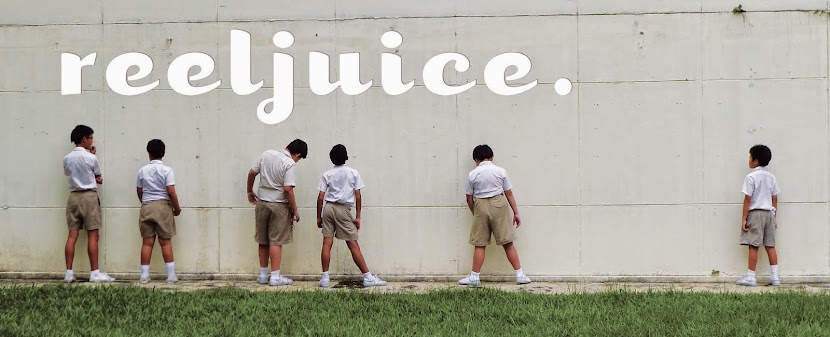It was inevitable. Yeah, another cooking show.
4 years after I did Vanila, the delectable food show hosted by baking chef, Siti Mastura, the opportunity to do Delicatessen II came a knocking.
It seems that I can never get away from food programmes, or could it be, food programmes always find me! I've always enjoyed doing food/culinary programmes. How does one present the flavours to the audience within a 2 dimensional format, out of the goggle box? How does one bring out the taste of the food?
Now that's a challenge!
Delicatessen II follows Yan, a new chef, as he ventures to set-up his own restaurant business. Delicatessen I saw him overcoming the odds in his decision to leave business school to become a chef. The show stars real-life Chef Sufiyan Safee who runs his own restaurant Jimmy Monkey at Ayer Rajah.
To elevate this series from becoming just another generic adventurous-young-chef cooking show, I've added the element of mock interviews by Yan, which of course were all scripted. I enjoyed working with Sufiyan. However being untrained in acting, he struggled with the dramatic aspect of the show as required by the show's concept. Understandably he received a lot of flak for being wooden. His lack of acting training was heightened when he was paired with prolific actor Hasnul Rahmat, who plays Yan's camp nemesis in the kitchen. Besides Hasnul, there were also established ensemble of regulars like Era Farida, Jasmani Basri, Fadly Awaludin, Nurul Akmar Elias and Fadhilah Samsudin.
I've always wanted to do a mockumentary series. The successful BBC series The Office has always inspired me to do an adaptation. The challenge for me in Delicatessen II, which incorporates real cooking segments with a scripted dramatic narrative, is to blend these elements successfully without making it tacky. Good, sharp editing helped the pacing and narrative. I recall the network cautioned against being too ambitious about such narrative structure (when I suggested the mock interviews element at the last minute) because previously producers had attempted similar structure on other programmes but it had not worked. I have to admit that such note stressed me a bit!
Delicatessen II without the mock interviews would be similar in execution to another 'dramedy' food show SOO LAZAT that I directed/produced previously for two seasons. SOO LAZAT stars the effervescent Rahimah Rahim as the matriarch who was desperate to marry off her daughters played by beauties Norfasarie, Fizah Nizam and Hetty Sarlene (who left after season one).
I think the mock interviews worked. These interviews highlight Yan's naivety and Sufiyan's natural awkwardness to the character's advantage.
The way to make such complex, multi-narrative structure work is to keep the edit in focus, be succinct with the pacing and constantly keeping the narrative arc in check.
Delicatessen II was telecast from 23 February 2012 through April for 8 weeks.
4 years after I did Vanila, the delectable food show hosted by baking chef, Siti Mastura, the opportunity to do Delicatessen II came a knocking.
It seems that I can never get away from food programmes, or could it be, food programmes always find me! I've always enjoyed doing food/culinary programmes. How does one present the flavours to the audience within a 2 dimensional format, out of the goggle box? How does one bring out the taste of the food?
Now that's a challenge!
Delicatessen II follows Yan, a new chef, as he ventures to set-up his own restaurant business. Delicatessen I saw him overcoming the odds in his decision to leave business school to become a chef. The show stars real-life Chef Sufiyan Safee who runs his own restaurant Jimmy Monkey at Ayer Rajah.
To elevate this series from becoming just another generic adventurous-young-chef cooking show, I've added the element of mock interviews by Yan, which of course were all scripted. I enjoyed working with Sufiyan. However being untrained in acting, he struggled with the dramatic aspect of the show as required by the show's concept. Understandably he received a lot of flak for being wooden. His lack of acting training was heightened when he was paired with prolific actor Hasnul Rahmat, who plays Yan's camp nemesis in the kitchen. Besides Hasnul, there were also established ensemble of regulars like Era Farida, Jasmani Basri, Fadly Awaludin, Nurul Akmar Elias and Fadhilah Samsudin.
I've always wanted to do a mockumentary series. The successful BBC series The Office has always inspired me to do an adaptation. The challenge for me in Delicatessen II, which incorporates real cooking segments with a scripted dramatic narrative, is to blend these elements successfully without making it tacky. Good, sharp editing helped the pacing and narrative. I recall the network cautioned against being too ambitious about such narrative structure (when I suggested the mock interviews element at the last minute) because previously producers had attempted similar structure on other programmes but it had not worked. I have to admit that such note stressed me a bit!
Delicatessen II without the mock interviews would be similar in execution to another 'dramedy' food show SOO LAZAT that I directed/produced previously for two seasons. SOO LAZAT stars the effervescent Rahimah Rahim as the matriarch who was desperate to marry off her daughters played by beauties Norfasarie, Fizah Nizam and Hetty Sarlene (who left after season one).
I think the mock interviews worked. These interviews highlight Yan's naivety and Sufiyan's natural awkwardness to the character's advantage.
The way to make such complex, multi-narrative structure work is to keep the edit in focus, be succinct with the pacing and constantly keeping the narrative arc in check.
Delicatessen II was telecast from 23 February 2012 through April for 8 weeks.





